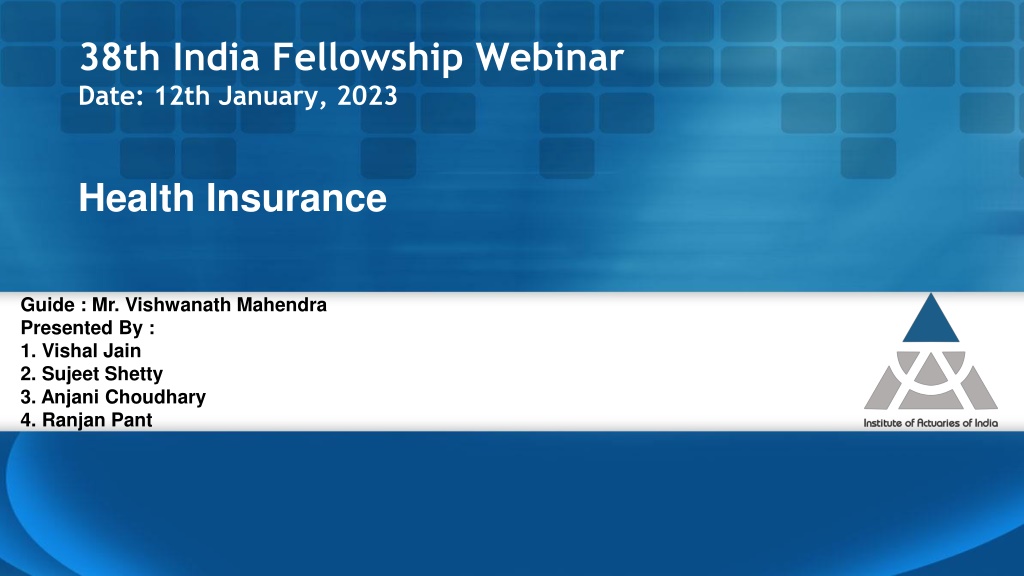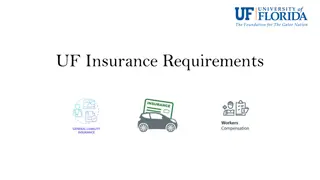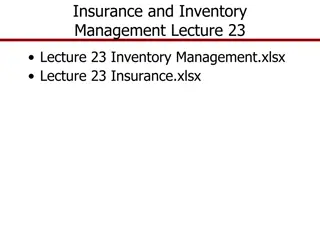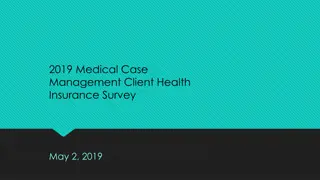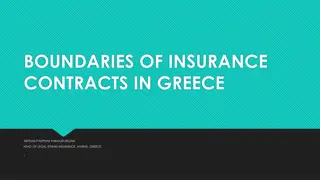Health Insurance
Gain valuable insights from the 38th India Fellowship Webinar on Health Insurance, featuring Mr. Vishwanath Mahendra, an accomplished actuary with extensive experience in the sector. Explore key topics such as regulatory impacts, market dynamics, and pricing considerations for health insurance products. Discover strategies for leveraging evolving regulatory frameworks and maximizing growth opportunities in the health insurance market.
Download Presentation

Please find below an Image/Link to download the presentation.
The content on the website is provided AS IS for your information and personal use only. It may not be sold, licensed, or shared on other websites without obtaining consent from the author. Download presentation by click this link. If you encounter any issues during the download, it is possible that the publisher has removed the file from their server.
E N D
Presentation Transcript
38th India Fellowship Webinar Date: 12th January, 2023 Health Insurance Guide : Mr. Vishwanath Mahendra Presented By : 1. Vishal Jain 2. Sujeet Shetty 3. Anjani Choudhary 4. Ranjan Pant
About our guide Vishwanath Mahendra, Appointed Actuary, Niva Bupa He has more than 25 years of rich experience in analytics, actuarial and finance in some of the reputed organisations in India. He is currently working with Niva Bupa Health Insurance Company Limited as Director and Chief Actuary and is a key member of the Executive Leadership team. In his previous stint he has worked with Apollo Munich Health Insurance Company Limited for almost 12 years and was holding position of Chief Actuary and Chief Risk Officer at the time of exit as part of the key leadership team. He is a Fellow Member of The Institute of Cost Accountants of India (erstwhile ICWAI), Fellow Member of Institute and Faculty of Actuaries (IFoA), UK and Institute of Actuaries of India (IAI) with specialisation in Health and Care Insurance. He is Chairman of Advisory Group on Health Care Insurance of IAI. 2 www.actuariesindia.org
Background A general insurance company in India started operations 4 years back with a focus on Motor insurance. With the recent surge seen in Health insurance during Covid, the management has decided to increase focus on the Health insurance business and double the contribution of the same in their books in the next 3 years. www.actuariesindia.org
Topics Covered The recent regulations and the key risks before expanding into health insurance Impact and implication of standard products introduced by the regulator Pricing considerations for products given the lack of any data. Impact on liquidity and solvency of the insurance company with the increasing proportion of Health business. www.actuariesindia.org
Changing Market dynamics Inorganic growth in Health insurance over last few years vs other LOB 10% Health insurance LOB in Private GI grew by 26% p.a. in last 5 years while Motor insurance grew by 11% p.a clearly indicating increased focus by Pvt GI 9% 18% Opening up of economy post COVID saw better growth in Motor insurance @ 17% (YTD Nov 22 over YTD Nov 21), but still lower than Health @ 23% 4% CAGR Amount in INR 000 Crores In Health, both Retail and Group (other than Govt) segment are primary contributor Source : IRDAI Segment-wise Premium Figures www.actuariesindia.org
Evolving Regulatory framework IRDAI planned out many programs with main objective of Insurance for all by 2047 Given least penetration, Health Insurance has biggest scope Motor had seen upscale with change in Traffic regulations Increasing Insurance Penetration Transition Increasing Consumer Protection More conducive environment for Insurers Bima Sugam one stop shop, an electronic Insurance program Every insurer will take part and contribute to cost Low acquisition cost model if able to get volume Key drivers - Correct pricing & quality service Reducing reporting requirement Phase Alignment with International Markets Bima Vahaak, Bima Vistaar etc www.actuariesindia.org
Evolving Regulatory framework Increasing Insurance Penetration Use and File for Individual products: No waiting for approval helps quick launch Re-pricing still conditional and hence correct pricing is must Transition Increasing Consumer Protection More conducive environment for Insurers Opening up of Corporate agency and IMF: Increasing number of relations to 9+9+9 instead of 3+3+3 increases opportunity Reducing reporting requirement Phase Alignment with International Markets www.actuariesindia.org
Evolving Regulatory framework Expense of Management and Commission payment Allowed EOM = 30%+ for GI 3 years extension for existing players HI is high acquisition business 3 year business growth should met EOM target Flexibility to decide commission rate would support desired growth (but overall EOM should be met) Increasing Insurance Penetration Transition Increasing Consumer Protection More conducive environment for Insurers Reducing reporting requirement Phase Alignment with International Markets Other form of capital No Prior approval + enhanced limits Can be used as alternative to support growth www.actuariesindia.org
Evolving Regulatory framework Implementation of IFRS 17 Yet to be notified in India Still not clear if Health insurance products would qualify for PAA Business plan to include time & effort of BBA method Increasing Insurance Penetration Transition Increasing Consumer Protection More conducive environment for Insurers Risk Based Capital framework: Currently Motor and Health LOB have similar solvency New framework might have differentiated solvency Current Economic capital framework requires lower solvency for Health vs Motor Diversification can provide solvency benefit Reducing reporting requirement Phase Alignment with International Markets www.actuariesindia.org
Evolving Regulatory framework While Bima Sugam would create more awareness and help end consumer, IRDAI focused to increase Consumer protection and build required trust in the industry Mandating insurers to pay all genuine COVID claim irrespective of T&C and pricing Standardization of product exclusions, cover mental illness diseases Increasing Insurance Penetration Transition Increasing Consumer Protection More conducive environment for Insurers Reducing reporting requirement Phase Alignment with International Markets Pricing should consider updated Regulations & Circulars while benchmarking with Competition www.actuariesindia.org
Evolving Regulatory framework Increasing Insurance Penetration Ensuring Regulatory architecture is aligned with Market dynamic Revisiting all Regulations and Circulars with objective to scrap non-warranted reporting requirement and increase efficiencies Eg: HIR returns, Reinsurance regulations, repealing of Old circulars etc. Transition Increasing Consumer Protection More conducive environment for Insurers Reducing reporting requirement Phase Alignment with International Markets www.actuariesindia.org
Other considerations on expansion Risk Opportunity Increased awareness of Health insurance post COVID Higher growth prospects given low penetration Regulator pushing for increased penetrations Opening up of Corporate agency Given high growth potential, competitions from existing and new entrants Health Insurance is a sensitive subject involving emotions sale and servicing expertise are different than Motor Insurance Uncertainties of COVID and similar pandemic Unprecedented medical trend post pandemic www.actuariesindia.org
Objectives of standard product Standard product as per extant guidelines*- Arogya Sanjeevani The primary objective in bringing in a standard individual health product are: to take care of basic health needs of insuring public to have a standard product with common policy wordings across the industry to facilitate seamless portability among insurers *IRDAI/HLT/REG/CIR/001/01/2020 dated. 1st January, 2020 www.actuariesindia.org
Product features- brief Feature Min/Max Sum Insured Policy term Arogya Sanjeevani INR 50,000 / 10,00,000 1 year 2% of SI subject to max of INR 5,000 per day 5% of SI subject to max of INR 10,000 per day Covered without any sub-limits All day care treatments are covered 4 years Increase in SI by 5% for each claim free year; maximum of 50% of SI 30/ 60 days 5% co pay on all claims Not allowed Cap on Room rent ICU/ICCU charges Ayush treatment Day care treatments Waiting period Cumulative bonus Pre/Post hospitalisation period Co-pay Add-ons or Optional covers www.actuariesindia.org
Implications of standard product (+) Easier for customers to compare the product features as well as premium rates (-) much higher SI amounts are being offered (-) products with no cap or much relaxed room rent/ICU charges (-) Waiting period can be lower (-) Maternity benefits, Health Check-up benefits, Organ Donor expenses (+) End goal of the Regulator of Health Insurance Coverage for all is being fulfilled www.actuariesindia.org
Other standard products Corona Kavach Individual/Floater basis Indemnity based cover SI: INR 50,000 to 5,00,000 Policy period: 3.5, 6.5 and 9.5 months Coverage: Hospitalization expenses incurred for the treatment of Covid on Positive diagnosis of Covid Premium under this product shall be Pan India basis; no geographic location based pricing is allowed Corona Rakshak Individual basis Fixed benefit cover SI: INR 50,000 to 2,50,000 Policy period: 3.5, 6.5 and 9.5 months Coverage: 100% of the SI shall be payable on positive diagnosis of Covid, requiring hospitalization for a minimum continuous period of 72 hours www.actuariesindia.org
Differential product features Coverage for longer term (say 2- 3 years) Top-up covers, possibly for smaller amounts Abroad/international cover Combi products: Health plus Life Product (Pure protection or savings products) Add-on covers for cancer care, possibly with sub-limits -Intent of the Regulator is good, but some flexibility could allow insurers to add more value and make it an even better offering for the customer www.actuariesindia.org
Health Insurance Design Health Insurance Contribution The gross direct premiums income from the health insurance constitutes sizeable proportion of the total non-life insurance gross premiums. Types of health insurance products sold by general insurance companies Indemnity and fixed cover products Hospitalization Cover OPD cover Surgical Cash cover Individual / Family floater cover www.actuariesindia.org
Pricing Considerations Data Considerations Data availability? Alternate sources of data for calculating the incidence and severity Design Considerations Technical aspects of pricing and product design Risk Considerations Risk management inbuilt into pricing and design www.actuariesindia.org
Pricing Considerations Data Considerations Data Sources like IIB data global data, reinsurer s data, public disclosure information of health insurers. Nature of data is the key when choosing the data source in terms of reliability, relevance, credibility, usability to link to pricing and product design. Benchmarking the cost estimates with the industry. www.actuariesindia.org
Pricing Considerations Pricing and Design Considerations Calculation of burning cost includes Claims frequency Claims severity Pricing to allow for medical inflation Assumptions for Waiting period, cost sharing arrangements. Premiums to be loaded for management expense and margins and unknown unknowns due to lack of data. Benchmarking the rates with the industry www.actuariesindia.org
Pricing Considerations Risk Considerations Product features like waiting period, exclusions, underwriting, co-pay, deductibles, pre-existing disease. Premium reviewability Reinsurance arrangements Quota share Distribution channel target market -Anti-selection Modelling risk lack of existing model, outsourcing Risk of cross-subsidies Policy wordings - terms and conditions www.actuariesindia.org
Impact on Solvency and Liquidity Solvency As per IRDAI ALSM (GI) Regulations 2016, Solvency Ratio of the company would be estimated as Available Solvency Margin (ASM) / Required Solvency Margin (RSM) ASM-Excess of value of Assets over value of liabilities RSM-Calculated using factor-based formula on net premium and net incurred claims As per IRDAI s guidelines, insurers are required to maintain a solvency ratio of 150% to minimize bankruptcy risk. Increase in the health business volume is likely to increase the NB strain Increase in Mathematical Reserves and initial acquisition expenses This would result in a reduction in the Available Solvency Margin (ASM) since premium inflows would be received over the term of the policy There would be an increase in the Required Solvency Margin (RSM) due to increase in net premium and incurred claims In summary there would be capital requirement to be met by the company as a result of aggressive business growth www.actuariesindia.org
Impact on Solvency and Liquidity Liquidity Insurer will need to ensure that it has sufficient liquidity to meet the expenses and outgoes related to business. Asset-Liability matching by duration can help maintain required liquidity Insurer need to ensure that assets backing the liabilities are sufficiently liquid, i.e. can be converted into cash without a material impact on price Adherence to IRDAI (Investments) regulations 2016 would be useful in maintaining required liquidity Insurer can also develop and monitor a liquidity indicator such as Liquidity Ratio = (Expected Income and Receipts in next 12 months + Liquid assets) / (Projected Expenses & Outgoes in next 12 months) This ratio can be estimated under base and stress scenarios Stress scenarios can be around new business volumes, claims outgo, investment income, expenses, etc. Incorporating NB expansion in this ratio would help the insurer identify the future investments www.actuariesindia.org
Solvency Projections: Illustrative Example Year 0 Year 3 8,000 6,000 7,000 5,103 5,000 7,000 5,000 6,000 4,000 4,500 5,000 4,000 3,000 2,500 3,000 2,000 2,000 1,000 1,000 103 0 0 ASM RSM Surplus (ASM-RSM) ASM RSM Surplus (ASM-RSM) ASM RSM Surplus (ASM-RSM) ASM RSM Surplus (ASM-RSM) Category Year 0 Year 1 Year 2 Year 3 ASM 7,000 6,300 5,670 5,103 RSM 2,500 3,125 3,906 5,000 Surplus (ASM-RSM) 4,500 3,175 1,764 103 Solvency Ratio 280% 202% 145% 102% Above illustration outlines the need for additional capital to support insurer s expansion plan www.actuariesindia.org
Capital Management Sources of Capital Internally by way of portfolio optimization, expense management, claims management etc. Capital infusion by the Shareholders Risk transfer by way of reinsurance could generate capital relief As per IRDAI (Other Forms of Capital) Regulations, 2022 insurer could raise capital through Preference Share Capital Subordinated Debt subject to limits and conditions laid out in the regulations www.actuariesindia.org
Questions? www.actuariesindia.org
Thank you! www.actuariesindia.org
